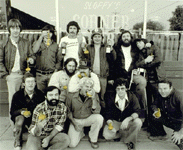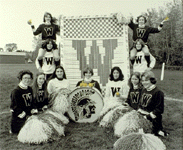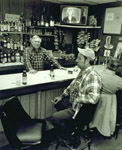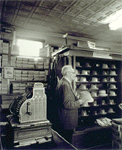the INCREDIBLE ONION PORTRAITS
I began the Onion Portraits in the fall of 1976. I had been living in Winooski
Vermont since 1969, and had discovered in the downtown of this former mill
town a rich and diverse social fabric. Rents were cheap in Winooski after
the mills closed in the 1950s, and there was a lively interplay of young
and old, of workers and artists, and of persons from varied social, economic
and ethnic backgrounds that gathered daily in the many neighborhood bars,
restaurants, diners, barber shops, pool halls, and bingo parlor.
In the early 1970s I watched as much of the downtown was demolished
as part of an Urban Renewal program. City blocks were knocked down, neighborhood
businesses were forced to close, and families and long term residents were
relocated to the outskirts of town. By 1980 the mix of personalities, the
story telling in the diners, the interactions of the shuffleboard leagues
were gone and all that was left of the Urban Renewal site was a widened
highway, a bank, and a parking lot.
 
1971
1976
aerial view of Winooski, 1971
Video
of Demolition, 1972
It was in that context that I began the Onion Portraits as both
a documentation and celebration of a community that was under assault.
I chose the onion as prop, appropriate  not
only because the townís name, Winooski, is the Abenaki word for wild not
only because the townís name, Winooski, is the Abenaki word for wild  onions
growing along its river, but because the onion is strong and reeks of a
flavor unsettling to a gentrified sensibility. I saw it as an unpretentious
way of residents affirming their presence in the community. Each day during
October 1976 I exhibited a new
Onion Portrait in the window of an
unoccupied storefront still remaining on the west side of Main street.
As the photos accumulated they spilled into the windows of other establishments
on Main street and the exhibition became a kind of local theater. By the
end of the month many people were asking me to come into their homes and
photograph them for the project. onions
growing along its river, but because the onion is strong and reeks of a
flavor unsettling to a gentrified sensibility. I saw it as an unpretentious
way of residents affirming their presence in the community. Each day during
October 1976 I exhibited a new
Onion Portrait in the window of an
unoccupied storefront still remaining on the west side of Main street.
As the photos accumulated they spilled into the windows of other establishments
on Main street and the exhibition became a kind of local theater. By the
end of the month many people were asking me to come into their homes and
photograph them for the project.
THE WINOOSKI PHOTOGRAPHS
During the 1970s and 1980s I continued to document the social life
of Winooski, exploring social situations as they arose, broadening my field
to include institutions such as schools, churches, fire department, senior
centers, and so on. I made photographs of people and places central to
the social life and exhibited the work in local cafes and storefront
windows. In 1991, responding to the emptiness of the downtown and
loss of community, I produced a mock 12 Days of Christmas portfolio, inviting
former residents to be photographed in my studio. Later, in the darkroom
I recreated a full community of coffee servers, cooking chefs, plumbers,
pipers, dancing ladies and leaping lords, a project that reached many former
residents when it was featured by local media.
  
In 1993 , as Winooski became a focus for
Refugee Resettlement programs, I began a new series of "Onion Portraits", photographing immigrant families from who
of "Onion Portraits", photographing immigrant families from who  have
resettled in Winooski from places like Vietnam, Bosnia and Iraq, asking
them to pose with the requisite onion and include in the picture memorabilia,
photos or objects that give clues about the places they left behind. There
is an ironic symmetry in that while the Federal programs of the 1970s were
responsible for the destruction of community, it is the Federally subsidized
Refuge Resettlement Program of the 1990s that is making the social life
of Winooski more diverse and interesting. have
resettled in Winooski from places like Vietnam, Bosnia and Iraq, asking
them to pose with the requisite onion and include in the picture memorabilia,
photos or objects that give clues about the places they left behind. There
is an ironic symmetry in that while the Federal programs of the 1970s were
responsible for the destruction of community, it is the Federally subsidized
Refuge Resettlement Program of the 1990s that is making the social life
of Winooski more diverse and interesting.
The Onion Portraits continue to speak of specificity. To pose with the
onion is to participate in local lore; Its embrace is an affirmation of
locality.
return to Dan's home page |





 not
only because the townís name, Winooski, is the Abenaki word for wild
not
only because the townís name, Winooski, is the Abenaki word for wild  onions
growing along its river, but because the onion is strong and reeks of a
flavor unsettling to a gentrified sensibility. I saw it as an unpretentious
way of residents affirming their presence in the community. Each day during
October 1976 I exhibited a new
Onion Portrait in the window of an
unoccupied storefront still remaining on the west side of Main street.
As the photos accumulated they spilled into the windows of other establishments
on Main street and the exhibition became a kind of local theater. By the
end of the month many people were asking me to come into their homes and
photograph them for the project.
onions
growing along its river, but because the onion is strong and reeks of a
flavor unsettling to a gentrified sensibility. I saw it as an unpretentious
way of residents affirming their presence in the community. Each day during
October 1976 I exhibited a new
Onion Portrait in the window of an
unoccupied storefront still remaining on the west side of Main street.
As the photos accumulated they spilled into the windows of other establishments
on Main street and the exhibition became a kind of local theater. By the
end of the month many people were asking me to come into their homes and
photograph them for the project.
 of "Onion Portraits", photographing immigrant families from who
of "Onion Portraits", photographing immigrant families from who  have
resettled in Winooski from places like Vietnam, Bosnia and Iraq, asking
them to pose with the requisite onion and include in the picture memorabilia,
photos or objects that give clues about the places they left behind. There
is an ironic symmetry in that while the Federal programs of the 1970s were
responsible for the destruction of community, it is the Federally subsidized
Refuge Resettlement Program of the 1990s that is making the social life
of Winooski more diverse and interesting.
have
resettled in Winooski from places like Vietnam, Bosnia and Iraq, asking
them to pose with the requisite onion and include in the picture memorabilia,
photos or objects that give clues about the places they left behind. There
is an ironic symmetry in that while the Federal programs of the 1970s were
responsible for the destruction of community, it is the Federally subsidized
Refuge Resettlement Program of the 1990s that is making the social life
of Winooski more diverse and interesting.